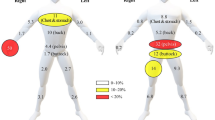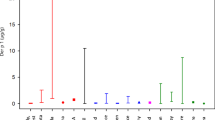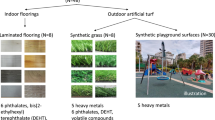Abstract
The transfer of pesticides from household surfaces to foods was measured to determine the degree of excess dietary exposure that occurs when children's foods contact contaminated surfaces prior to being eaten. Three household flooring surfaces (ceramic tile, hardwood, and carpet) were contaminated with an aqueous emulsion of commercially available pesticides (diazinon, heptachlor, malathion, chlorpyrifos, isofenphos, and cis- and trans-permethrin) frequently found in residential environments. A surface wipe method, as typically used in residential exposure studies, was used to measure the pesticides available on the surfaces as a basis for calculating transfer efficiency to the foods. Three foods (apple, bologna, and cheese) routinely handled by children before eating were placed on the contaminated surfaces and transfers of pesticides were measured after 10 min contact. Other contact durations (1 and 60 min) and applying additional contact force (1500 g) to the foods were evaluated for their impact on transferred pesticides. More pesticides transferred to the foods from the hard surfaces, that is, ceramic tile and hardwood flooring, than from carpet. Mean transfer efficiencies for all pesticides to the three foods ranged from 24% to 40% from ceramic tile and 15% to 29% from hardwood, as compared to mostly non-detectable transfers from carpet. Contact duration and applied force notably increased pesticide transfer. The mean transfer efficiency for the seven pesticides increased from around 1% at 1 min to 55– 83% when contact duration was increased to 60 min for the three foods contacting hardwood flooring. Mean transfer efficiency for 10-min contact increased from 15% to 70% when a 1500 g force was applied to bologna placed on hardwood flooring. Contamination of food occurs from contact with pesticide-laden surfaces, thus increasing the potential for excess dietary exposure of children.
This is a preview of subscription content, access via your institution
Access options
Subscribe to this journal
Receive 6 print issues and online access
$259.00 per year
only $43.17 per issue
Buy this article
- Purchase on Springer Link
- Instant access to full article PDF
Prices may be subject to local taxes which are calculated during checkout



Similar content being viewed by others
Abbreviations
- ASE:
-
accelerated solvent extraction
- BQL:
-
below quantitation limit
- DCA:
-
9,10-dichloroanthracene
- ECD:
-
electron capture detector
- GC:
-
gas chromatography
- QA:
-
quality assurance
- QC:
-
quality control
- RH:
-
relative humidity
- RSD:
-
relative standard deviation
- TE:
-
transfer efficiency
References
Akland G., Pellizzari E.D., Hu Y., Roberds J.M., Rohrer C.A., Leckie J.O., and Berry M.R . Factors influencing total dietary exposures of young children. J Expos Anal Environ Epidemiol 2000: 10(6 Part 2): 710–722.
Bearer C . How are children different from adults? Env Health Persp 1995: 103(6): 7–12.
Berry M.R . Advances in dietary exposure research at the United States Environmental Protection Agency-National Exposure Research Laboratory. J Expos Anal Environ Epidemiol 1997: 7: 3–16.
Berry M.R., Johnson L.S., Jones J.W., Rader J.I., Kendall D.C., and Sheldon L.S . Dietary characterizations in a study of human exposures in the Lower Rio Grande Valley: 1. Foods and beverages. Environ Int 1997: 23(5): 675–692.
Bradman M.A., Harnly M.E., Draper W., Seidel S., Teran S., Wakeham D., and Neutra R . Pesticide exposures to children from California's Central Valley: results of a pilot study. J Expos Anal Environ Epidemiol 1997: 7(2): 217–234.
Brouwer D.H., Kroese R., and Van Hemmen J.J . Transfer of contaminants from surface to hands: experimental assessment of linearity of the exposure process, adherence to the skin, and area exposed during fixed pressure and repeated contact with surfaces contaminated with a powder. Appl Occup Environ Hyg 1999: 14(4): 231–239.
Byrne S.L., Shurdut B.A., and Saunders D.G . Potential chlorpyrifos exposure to residents following standard crack and crevice treatment. Env Health Persp 1998: 106(11): 725–731.
Camann D.E . Protocol to determine dermal transfer efficiency of pesticides from used cut-pile carpet to dry and wetted palms. Experiment 6.2 of Work Assignment II-47. Southwest Research Institute, San Antonio, TX, 1998.
Cohen-Hubal E.A., Sheldon L.S., Burke J.M., McCurdy T.R., Berry M.R., Rigas M.L., Zartarian V.G., and Freeman N.C.G . Children's exposure assessment: a review of factors influencing children's exposure, and the data available to characterize and assess that exposure. Env Health Persp 2000: 108(6): 475–486.
Eskenazi B., Bradman A., and Castorina R . Exposures of children to organophosphate pesticides and their potential adverse health effects. Env Health Persp 1999: 107(Suppl 3): 409–419.
Fenske R.A., Black K.G., Elkner K.P., Lee C.L., Methner M.M., and Soto R . Potential exposure and health risks of infants following indoor residential pesticide applications. Am J Public Health 1990: 80(6): 689–693.
Freeman N.C.G., Ettinger A., Berry M.R., and Rhoads G . Hygiene-and food-related behaviors associated with blood lead levels of young children from lead-contaminated homes. J Expos Anal Environ Epidemiol 1997: 7: 103–118.
Freeman N.C.G., Sheldon L., Jimenez M., Melnyk L., Pellizzari E., and Berry M. Contribution of children's activities to lead contamination of food. J Expos Anal Environ Epidemiol 2001: 11: 407–413.
Geno P.W., Camann D.E., Harding H.J., Villalobos K., and Lewis R.G . Handwipe sampling and analysis procedure for the measurement of dermal contact with pesticides. Arch Environ Contam Toxicol 1996: 30: 132–138.
Gurunathan S., Robson M., Freeman N., Buckley B., Roy A., Meyer R., Bukowski J., and Lioy P.J . Accumulation of chlorpyrifos on residential surfaces and toys accessible to children. Env Health Persp 1998: 106: 9–16.
Lewis R.G. Fortmann R.C., and Camann D.E . Evaluation of methods for monitoring the potential exposure of small children to pesticides in the residential environment. Arch Environ Contam Toxicol 1994: 26: 37–46.
Lewis R.G., Fortune C.R., Willis R.D., Camann D.E., and Antley J.T . Distribution of pesticides and polycyclic aromatic hydrocarbons in house dust as a function of particle size. Env Health Persp 1999: 107(9): 721–726.
Lu C., and Fenske R.A . Air and surface chlorpyrifos residues following residential broadcast and aerosol pesticide applications. Environ Sci Technol 1998: 32(10): 1386–1390.
Melnyk L.J., Berry M.R., and Sheldon L.S . Dietary exposure from pesticide application on farms in the agricultural health pilot study. J Expos Anal Env Epidemiol 1997: 7: 61–80.
Melnyk L.J., Berry M.R., Sheldon L.S., Freeman N.C.F., Pellizzari E.D., and Kinman R.N . Dietary exposure of children in lead-laden environments. J Expos Anal Environ Epidemiol 2000: 10(6 Part 2): 723–731.
Melnyk L.J., Bernard C.E., Morgan, and Berry M.R . Excess exposures of young children eating in contaminated environments. Environ Health Persp 2003. In review.
Mukerjee D . Assessment of risk from multimedia exposures of children to environmental chemicals. J Air Waste Manage Assoc 1998: 48(6): 483–501.
National Research Council (NRC). Pesticides in the Diets of Infants and Children. National Academy Press, Washington, DC, 1993.
Reed K.J . Quantification of children's hand and mouthing activities through a videotaping methodology. Ph.D. Thesis, Rutgers University, Piscataway, NJ, 1998.
Rosenblum L., Hieber T., and Morgan J . Determination of pesticides in composite dietary samples by gas chromatography/mass spectrometry in the selected ion monitoring mode using a temperature programmable large volume injector with pre-separation column. J AOAC Int 2001: 84(3): 891–900.
Silvers A., Florence B.T., Rourke D.L., and Lorimor R.J . How children spend their time: a sample survey for use in exposure and risk assessments. Risk Anal 1994: 14: 931–944.
Simcox N.J., Fenske R.A., Wolz S.A., Lee I.-C., and Kalman D.A . Pesticides in household dust and soil: exposure pathways for children of agricultural families. Env Health Persp 1995: 103(12): 1126–1134.
Thomas K.W., Sheldon L.S., Pellizzari E.D., Handy R.W., Roberds J.M., and Berry M.R . Testing duplicate diet sample collection methods for measuring personal dietary exposures to chemical contaminants. J Expos Anal Env Epidemiol 1997: 7: 17–36.
U.S. Department of Agriculture (USDA). Agricultural Research Service. USDA Nutrient Database for Standard Reference. Release 13. Nutrient Data Laboratory Home Page, http://www.nal.usda.gov/fnic/foodcomp, 1999.
U.S. Environmental Protection Agency (USEPA). Exposure Factors Handbook, Vol. III. EPA/600/P-95-002Fa, 1997, pp. 15–147.
Zartarian V.G., Ferguson A.C., and Leckie J.O . Quantified dermal activity data from a four-child pilot field study. J Expos Anal Env Epidemiol 1997: 7(4): 543–552.
Acknowledgements
The U.S. Environmental Protection Agency through its Office of Research and Development collaborated in the research, described here under NERL 98-01 to the Postgraduate Research Participation Program at the National Exposure Research Laboratory administered by the Oak Ridge Institute for Science and Education, through an interagency agreement between the U.S. Department of Energy and the U.S. Environmental Protection Agency.
Author information
Authors and Affiliations
Corresponding author
Additional information
Disclaimer
The U.S. Environmental Protection Agency through its Office of Research and Development funded and managed the research described in this paper. It has been reviewed in accordance with the Agency's peer and administrative review policies and approved for publication. Mention of trade names or commercial products does not constitute an endorsement or recommendation for use.
Rights and permissions
About this article
Cite this article
Rohrer, C., Hieber, T., Melnyk, L. et al. Transfer efficiencies of pesticides from household flooring surfaces to foods. J Expo Sci Environ Epidemiol 13, 454–464 (2003). https://doi.org/10.1038/sj.jea.7500300
Received:
Accepted:
Published:
Issue Date:
DOI: https://doi.org/10.1038/sj.jea.7500300
Keywords
This article is cited by
-
Influences on transfer of selected synthetic pyrethroids from treated Formica to foods
Journal of Exposure Science & Environmental Epidemiology (2011)
-
Surface-to-food pesticide transfer as a function of moisture and fat content
Journal of Exposure Science & Environmental Epidemiology (2009)
-
Assessing intermittent pesticide exposure from flea control collars containing the organophosphorus insecticide tetrachlorvinphos
Journal of Exposure Science & Environmental Epidemiology (2008)
-
Assessing transferable residues from intermittent exposure to flea control collars containing the organophosphate insecticide chlorpyrifos
Journal of Exposure Science & Environmental Epidemiology (2007)



